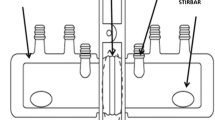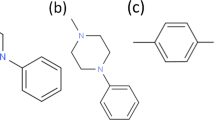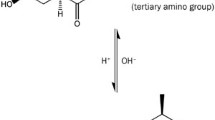Abstract
New data on the permeabilities of hydrophilic markers in two commonly used in vitro models, i.e., excised intestinal segments from the rat and monolayers of Caco-2 cells, are presented. The results are compared to human in vivo data. Two groups of hydrophilic marker molecules were tested: (1) monodisperse polyethylene glycols of molecular weights ranging from 194 to 502 g/mol and (2) a heterogeneous group of molecules consisting of urea, creatinine, erythritol, and mannitol (60–182 g/mol). The permeabilities of the marker molecules showed a nonlinear dependence on the molecular weight and decreased in the order rat ileum > rat colon > Caco-2 cells. Surprisingly, the polyethylene glycols permeated more easily than the other marker molecules, indicating that characteristics other than molecular weight, e.g., the flexibility of the structure, may also be important for permeation through the membrane. Comparisons with the published permeability profiles of polyethylene glycols in human intestinal segments in vivo (i.e., calculated permeability coefficients as a function of molecular weight) indicate that the human intestine is more permeable than the in vitro models. However, the permeability profiles of the corresponding segments in the human intestine and the in vitro models were comparable. Thus, good correlations were established between permeabilities of the human ileum and rat ileum and between those of human colon, rat colon, and the Caco-2 cells. We conclude that the paracellular absorption in humans can be studied mechanistically in these in vitro models.
Similar content being viewed by others
REFERENCES
D. Hollander. The intestinal permeability barrier. A hypothesis as to its regulation and involvement in Crohn's disease. Scand. J. Gastroenterol. 27:721–726 (1992).
D. W. Powell. Intestinal water and electrolyte transport. In L. R. Johnson (ed), Physiology of the Gastrointestinal Tract, Raven Press, New York, 1987, pp. 1267–1305.
G. Davis, C. Santa Ana, S. Morawski, and J. Fordtran. Permeability characteristics of human jejunum, ileum, proximal colon and distal colon: Results of potential difference measurements and unidirectional fluxes. Gastroenterology 83:844–850 (1982).
V. S. Chadwick, S. F. Phillips, and A. F. Hofmann. Measurements of intestinal permeability using low molecular weight polyethylene glycols (PEG 400). II. Application to normal and abnormal permeability states in man and animals. Gastroenterology 73:247–251 (1977).
D. Hollander, D. Ricketts, and C. A. R. Boyd. Importance of “probe” molecular geometry in determining intestinal permeability. Can. J. Gastroenterol. 2 (suppl. A):35A–38A (1988).
J. R. Pappenheimer. Physiological regulation of transepithelial impedance in the intestinal mucosa of rats and hamsters. J. Membr. Biol. 100:137–148 (1987).
S. G. Schultz. A cellular model for active sodium absorption by mammalian colon. Annu. Rev. Physiol. 46:435–451 (1984).
A. L. Ungell, A. Andreasson, K. Lundin, and L. Utter. Effects of enzymatic inhibition and increased paracellular shunting on the transport of vasopressin analogs in the rat. J. Pharm. Sci. 81:1–6 (1992).
I. J. Hidalgo, T. J. Raub, and R. T. Borchardt. Characterization of the human colon carcinoma cell line (Caco-2) as a model system for intestinal epithelial permeability. Gastroenterology 96:736–749 (1989).
G. Wilson, I. F. Hassan, C. J. Dix, I. Williamson, R. Shah, and M. Mackay. Transport and permeability properties of human Caco-2 cells: An in vitro model of the intestinal epithelial cell barrier. J. Control. Release 11:25–40 (1990).
P. Artursson. Epithelial transport of drugs in cell culture. I. A model for studying the passive diffusion of drugs over intestinal absorbtive (Caco-2) cells. J. Pharm. Sci. 79:476–482 (1990).
P. Artursson and J. Karlsson. Correlation between oral drug absorption in humans and apparent drug permeability coefficients in human intestinal epithelial (Caco-2) cells. Biochem. Biophys. Res. Comm. 175 (3):880–885 (1991).
J. Fogh, J. M. Fogh, and T. J. Orfeo. One hundred and twenty seven cultured human tumor cell lines producing tumors in nude mice. J. Natl. Cancer Inst. 59:221–226 (1977).
C. H. von Bonsdorff, S. D. Fuller, and K. Simons. Apical and basolateral endocytosis in Madin-Darby canine kidney (MDCK) cells grown on nitrocellulose filters. EMBO J. 4:2781–2792 (1985).
S. Woodcock, I. Williamson, I. Hassan, and M. Mackay. Isolation and characterisation of clones from the Caco-2 cell line displaying increased taurocholic acid transport. J. Cell. Sci. 98:323–332 (1991).
J. Karlsson and P. Artursson. A method for the determination of cellular permeability coefficients and aqueous boundary layer thickness in monolayers of intestinal epithelial (Caco-2) cells grown in permeable filter chambers. Int. J. Pharm. 71:55–64 (1991).
C. Tagesson and R. Sjödahl. Passage of molecules through the wall of the gastrointestinal tract. Urinary recovery of different-sized polyethylene glycols after intravenous and intestinal deposition. Scand. J. Gastroenterol. 19:315–320 (1984).
I. Komiya, J. Y. Park, A. Kamani, N. F. H. Ho, and W. I. Higuchi. Quantitative mechanistic studies in simultaneous fluid flow and intestinal absorption using steroids as model solutes. Int. J. Pharm. 4:249–262 (1980).
J. R. Pappenheimer. Paracellular intestinal absorption of glucose, creatinine, and mannitol in normal animals: Relation to body size. Am. J. Physiol. 259:G290–G299 (1990).
M. A. Marcial, S. L. Carlson, and J. L. Madara. Partitioning of paracellular conductance along the ileal crypt-villus axis: A hypothesis based on structural analysis with detailed consideration of tight junction structure-function relationships. J. Membr. Biol. 80:59–79 (1984).
J. L. Madara and J. S. Trier. Structure and permeability of goblet cell tight junctions in rat small intestine. J. Membr. Biol. 66:145–157 (1982).
L. Johansson, U. Skantze, and J. E. Löfroth. Diffusion and interaction in gels and solutions. II. Experimental results on the obstruction effect. Macromolecules 2:6019–6023 (1991).
J. A. McRoberts, R. Aranda, N. Riley, and H. Kang. Insulin regulates the paracellular permeability of cultured intestinal epithelial cell monolayers. J. Clin. Invest. 85:1127–1134 (1990).
J. L. Madara and K. Dharmsathaporn. Occluding junction structure-function relationships in a cultured epithelial monolayer. J. Cell Biol. 101:2124–2133 (1985).
H. Fujita. Polymer solutions. In Studies in Polymer Science, Vol. 9, Elsevier, Amsterdam, 1990.
L. Johansson, C. Elvingson, and J. E. Löfroth. Diffusion and interaction in gels and solutions. III. Theoretical results on the obstruction effect. Macromolecules 24:6024–6029 (1991).
Author information
Authors and Affiliations
Rights and permissions
About this article
Cite this article
Artursson, P., Ungell, AL. & Löfroth, JE. Selective Paracellular Permeability in Two Models of Intestinal Absorption: Cultured Monolayers of Human Intestinal Epithelial Cells and Rat Intestinal Segments. Pharm Res 10, 1123–1129 (1993). https://doi.org/10.1023/A:1018903931777
Issue Date:
DOI: https://doi.org/10.1023/A:1018903931777




